History of the Breed
Breed Standard
About the Breed
Home Page
About Me and the Dogs
View our dogs
History of the Breed in the United Kingdom
The breed at work - Shooting
Falconry
Deer Stalking
Puppy rearing
Variations in Coat
General Information
Links to Other Gundog Sites

The Ottoman Empire which lasted from 1299 - 1923 AD was vast and incorporated South-Eastern Europe, North America and the Persian Gulf, just to name a few. In North Africa and the Persian Gulf the nomads had, and still have, their sleek hounds like the Saluki and Sloughi, both very ancient dogs, and various other types. So logic says that some of the hounds of the time helped to make the Vizsla dog into what it is today. Our Wires obviously stem from all of the above, but in the 1930, only a few years after the end of the Ottoman Empire, a dog was required that could withstand the severe winters and harsh countryside (also very beautiful) of Hungary.

It was noticed that some Vizslas had thicker coats which gave them better protection in cover and water. One of these thicker coated bitches was crossed with a German Wirehaired Pointer. The breeder who did this was Mr. Vasas Jozsef. He tried two such matings with the same dog and different bitches: Zsussi & Csibi and the German Wirehaired Pointer, who was totally brown and called Astor von Potat, which produced the first wire which was called
Dia de Selle
After this Mr. Gresznaryk Laszlo, the owner of the Selle kennels (called the Father of the wirehairs), and Vasas Jozsef continued the breeding with a dog and bitch from the first matings:
Csabai Lurko x Csabai Lidi - Dia de Selle (1942)
In 1943 Vasa Jozsef requested the Hungarian Vizsla section to assist in breeding. There seems to have been a lot of 'Ums and Ahs' but finally it was agreed, and wirehaired vizslas were allowed to have non-official pedigrees.
As with all breeds, World War 2 caused a lot of problems for the HWV, but steadily it improved after the war and in 1966 the FCI finally acknowledged the Hungarian Wirehaired Vizsla as a completely independent breed in its own right.
In 1992 the first breeding Wires came into the UK, imported from Hungary; now they are being imported from all round Europe and the breed has never looked back.
History of the German Wirehaired Pointer
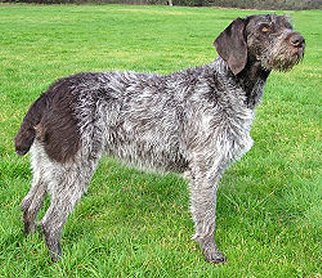 |
German Wirehaired Pointer |
The German Wirehaired Pointers trace their origins back about 120 years. They originated in Germany, where breeders wanted to develop a rugged, versatile hunting dog that would work closely with either one person or a small party of persons hunting on foot in varied terrain; from the mountainous regions of the Alps, to dense forests, to more open areas with farms and small towns. The breed the Germans desired had to have a coat that would protect the dogs when working in heavy cover or in cold water, yet be easy to maintain. Careful crosses of the German Pointer with many other breeds were made.
Sources differ on the exact lineage, though the Wirehaired Griffon seems the one most used. In historical Europe, 'Griffon' meant many dog breeds with the characteristic facial furnishings and wire coats. (Historical notes: First developed by a young Dutch Sportsman, Eduard Karel Korthals, in 1873 from a select group of Griffons of various breeds. His aim was to produce the ultimate companion for a walking hunter, capable of hunting in any terrain and under any weather. Selective breeding resulted in the Wirehaired Pointing Griffon. Korthals extolled the virtues of the new breed. In 1877 he received financial support from his father, a wealthy banker and cattle breeder, and a kennel facility provided by Prince Albrecht of Solms-Braunfels and thereafter dedicated himself to the development of the breed, with plenty of help from his friends in France, until his early death of laryngeal cancer.)
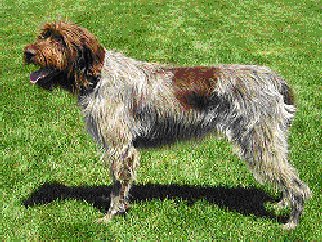 |
Wirehaired Pointing Griffon |
The German Stichelhaar is considered to be the oldest wirehaired working dog breed in Germany, Switzerland and Austria. Reaching a height of 70 cm and a weight of up to 30 kg, the breed is in appearance very similar to the German Wirehaired Pointer. Its hair is bristly to harsh, and up to 4 cm long. Coat color is usually brown with or without a heavy sprinkling of white hairs. Some specimens have brown roan or light roan coats that may or may not have brown patches. The ears are medium sized, hanging, highly set.
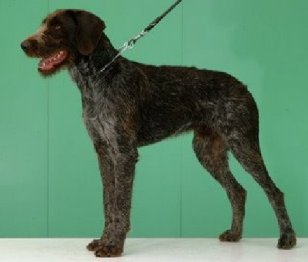 |
German Stichelhaar |
The Deutsch-Kurzhaar (UK -GSP - German Shorthaired Pointer) is commonly accepted as one of the most likely contributors. This is a dog that can fully respond to the needs of its hunter. And is also the most popular and well known throughout the world.
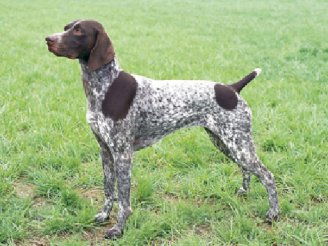 |
German Shorthaired Pointer |
Plus , of course the Püdelpointer ....In 1881, a German breeder, Baron von Zedlitz, worked on producing his ideal tracking, pointing, and retrieving gun dog, suitable for work on both land and water. From seven specific Poodles and nearly 100 different pointers, he developed the Püdel pointer. The original sire was Tell, an English Pointer belonging to Kaiser Frederick III and the original dam was a German hunting püdel named Molly who was owned by Hegewald, an author known for works on hunting dogs. The goal was to produce a dog that was willing and easy to train, intelligent, and loved water and retrieving, like the poodle, and add to that a great desire to hunt, a strong pointing instinct, and an excellent nose, like the English Pointer, as well as being an excellent companion in the home.
The Poodle breed had much stronger genes, and so many more Pointers were used to achieve the balanced hunting dog that was desired. A mix of 11 Püdels and 80 Pointers were used during the first 30 years to achieve the desired traits and results.
It has never become a popular or well-known breed. However, it is slowly gaining notoriety with many serious upland bird and waterfowl hunters in the U.S. and Canada. In Germany, its performance standards are its most important traits and each dog must pass a test of its field and water skills to be officially registered as a Püdel pointer.
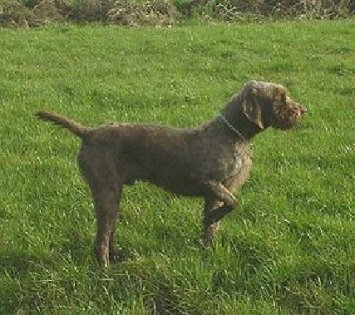 |
Püdel Pointer |
History of The Hungarian Vizsla
The Kingdom of Hungary (short form: Hungary), emerged in 1000, when the Principality of Hungary, founded in 896 was recognized as a Kingdom. The form of government was changed from Monarchy to Republic briefly in 1918 and again in 1946 ending the Kingdom and creating the Republic of Hungary. During most of its history it was a considerable state in Central Europe, including, besides Hungary proper and Transylvania, Croatia-Slavonia and a territory known as the Military Frontier.
The origins of the HV are very difficult to trace, but probably began in the 9th Century when the warring Magyar tribes migrated from the Steppes of Asia. They led a nomadic life until they settled in the Carpathian Basin (now known as Hungary), cattle breeding was an important part of their lives, as was hunting, the winters very harsh and the summers very hot.. On their travels their horses, sheep, cattle and herding dogs were very important, and it is believed today that the Hungarian herding breeds that we see today evolved from those early Magyar dogs.
Now, lets go to the times of Genghis Khan and peek through the mists of time: Born in 1162, when he was very young his father was poisoned and his mother Hoelun had to bring him & his brothers & sister up in pure poverty (the rest is history). He came to power by uniting many of the nomadic tribes of northeast Asia. After founding the Mongol Empire and being proclaimed "Genghis Khan", he started the Mongol invasions and raids of the Kara-Khitan Khanate, Caucasus, Khwarezmid Empire, Western Xia and Jin dynasties. During his life, the Mongol Empire eventually occupied a substantial portion of Central Asia. During his lifetime he conquered many regions of the world, including central Asia, China etc.
Living the lives that the tribes did, they too had herds of cattle, horses, camels and dogs, these dogs integrated with various dogs including the Yellow PointingDog/Yellow hunting dog/yellow Turkish dog. And when in 1241 they invaded Hungary, obviously the dogs of the area and the dogs of the tribes of Genghis Khan mixed. Hence it is thought that the very beginnings of the Vizsla stems from those times.
And the name Vizsla (which in the Hungarian language means Pointing dog) like all other pointing dogs in Hungarian, ie. German Wirehaired Vizsla, German shorthaired Vizsla etc., became, instead of the Yellow Hunting Dog, the Hungarian Vizsla.
The Vizsla is mentioned in the very early times in Hungarian history. It is known that the ancestors of the present Vizsla were the trusted and favourite hunting dogs of the Magyar tribes who lived in the Carpathian basin in the Eighth Century. Primitive stone etchings over a thousand years old show the Magyar hunter with his falcon and his Vizsla.
The first written reference to a Vizsla dog breed has been recorded in the Illustrated Vienna Chronicle prepared on order of King Lajos the Great (Louis the Great) by the Carmelite Friars in 1357.
Companion dogs of the early warlords and barons, Vizsla blood was preserved in purity for centuries by the land-owning aristocracy who guarded them jealously and continued to develop the hunting ability of these "yellow-pointers". Records of letters and writings show the high esteem in which the Vizsla was held.
The Vizsla survived the Turkish occupation (1526-1696), the Hungarian Civil War (1848-49), World War I, World War II and the Russian Occupation. However, Vizslas faced and survived several near-extinctions in their history, including being overrun by English Pointers and German Shorthaired Pointers in the 1800s and again to near-extinction after World War II. A careful search of Hungary and a poll of Hungarian sportsmen revealed only about a dozen Vizslas of the true type still alive in the country. From that minimum stock, the breed rose to prominence once again. The various "strains" of the Vizsla have become somewhat distinctive as individuals bred stock that suited their hunting style. The Austria-Hungary Empire extended its influence over a large area for many years, but with frequent border changes Hungary was reduced to a mere shadow of its former self. As a result, owners of Vizslas suddenly found themselves living in Czech Rep., Slovak Rep., Romania, the former Yugoslavia, Italy, Germany, Poland or Russia.
Back to the Vizsla: In its early days, the breed was bred with the the Yellow Turkish dogs, and latterly many other breeds are thought to have been in its bloodlines. Gay Gottlieb refers to Setters, Bloodhounds, the German Vortsthund, the Balkan Beagle, the ancient Foxhound, the Pammion Hound and the Romanian Copie, as well as the Greyhound and the Sloughi. Little wonder, then, that it carries such a variety of instincts and characteristics, all making it such a versatile breed and adaptable companion for many different types of owner.
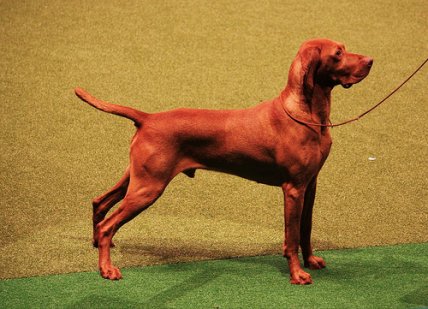 |
(As a matter of interest : It is believed two Vizslas were imported into the UK before the second World War in 1939. However, the first registration of imported Vizslas was recorded by the Kennel Club in 1953. Thereafter, between 1953 and 1955, there were three mating's from this pair - resulting in 13 puppies - with some being exported to America.)
History of the Breed in the United Kingdom
n the late 1970s a bitch, ARANYOS TISZU DUDAS (Zloty) was imported by Douglas and Carol Appleton. This bitch was later transferred into the ownership of David and Mic Layton. In 1983 a dog, BOROSTYANKO GULYAS OF CARRIGTEMPLE was imported by the Appletons as a mate for Zloty. Unfortunately she never conceived. The Appletons took the dog back abroad with them when they went to live in France.
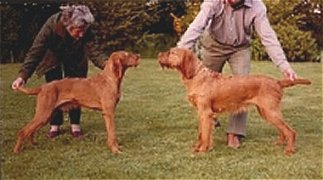 |
Carol Appleton with Gulyas and Douglas with Zloty |
The first Hungarian Wirehaired Vizsla to be shown at Crufts was shown by Mr. & Mrs. Appleton in 1980 in Any Variety Sporting - Not Separately Classified, Class 916 Open Bitch under Judge Mr. L.C. James. This was Aranyos-Tisza Dudus (Hungarian Wirehaired Vizsla) B 30/01/78 br Sipos Istvanne, Budaszentiorinci Bator - Szelei Biri.
We then had to wait until 1991, when Anna Coombe and Sheila Gray imported ABAFIA MAYA (bitch), born 29th April, 1990, and AMOR (dog), born 3rd November, 1989. They then produced the first litter in this country on 19th March, 1992. There were nine puppies. Amor became ill and died before another litter was possible.
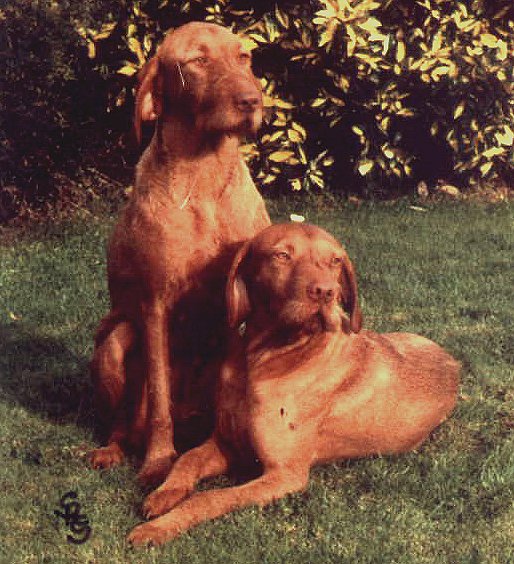 |
Maya (seated) and Amor |
The next import was HESTIA DU DOMAINE SAINT HUBERT, also owned by Anna and Sheila and now owned solely by Sheila.
Then came ABAFIA VEZER AT CASTLEFIELD, imported by Anna Coombe and Josephine Vinovich, and he sired the second litter out of Abafia Maya.